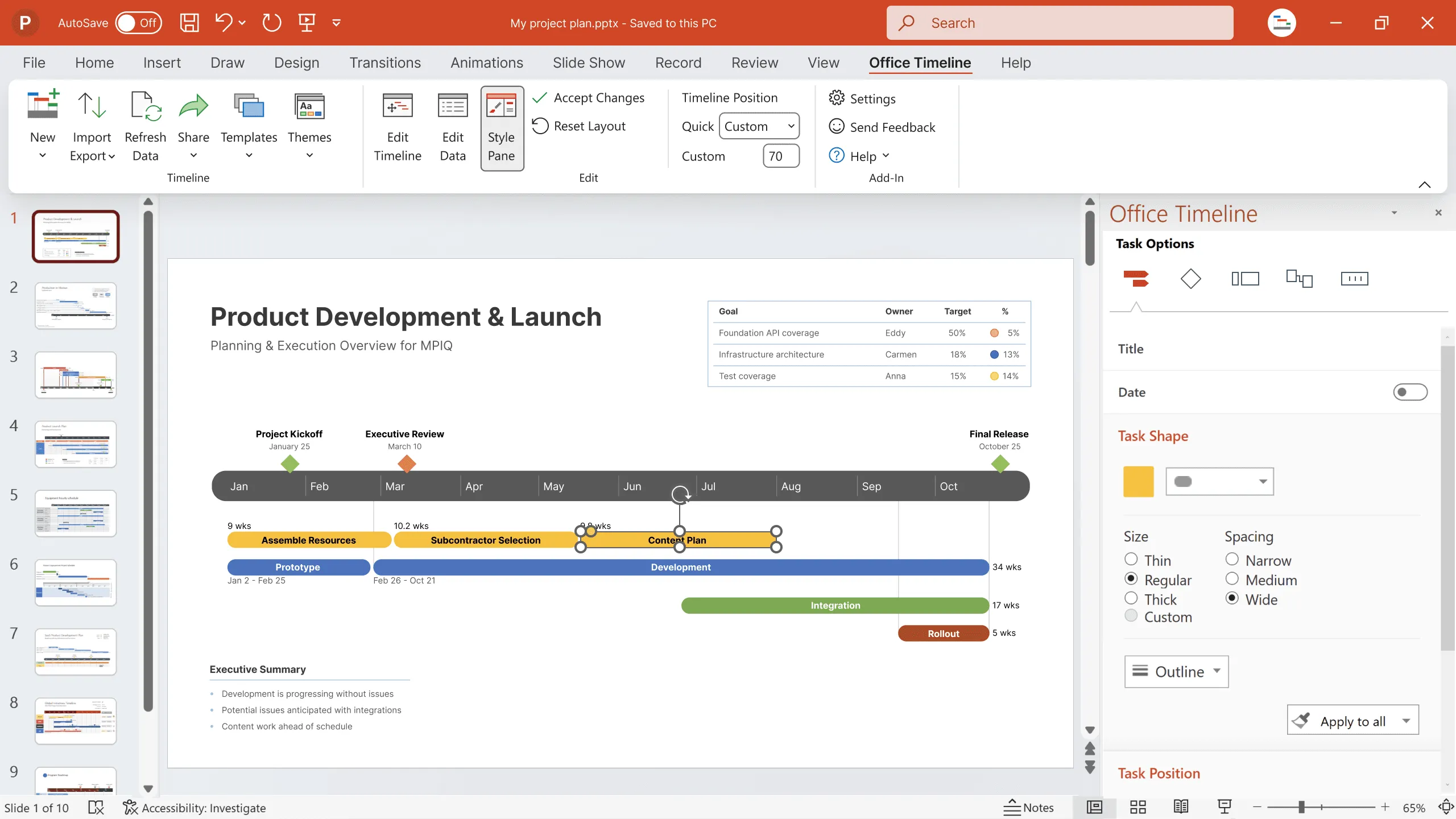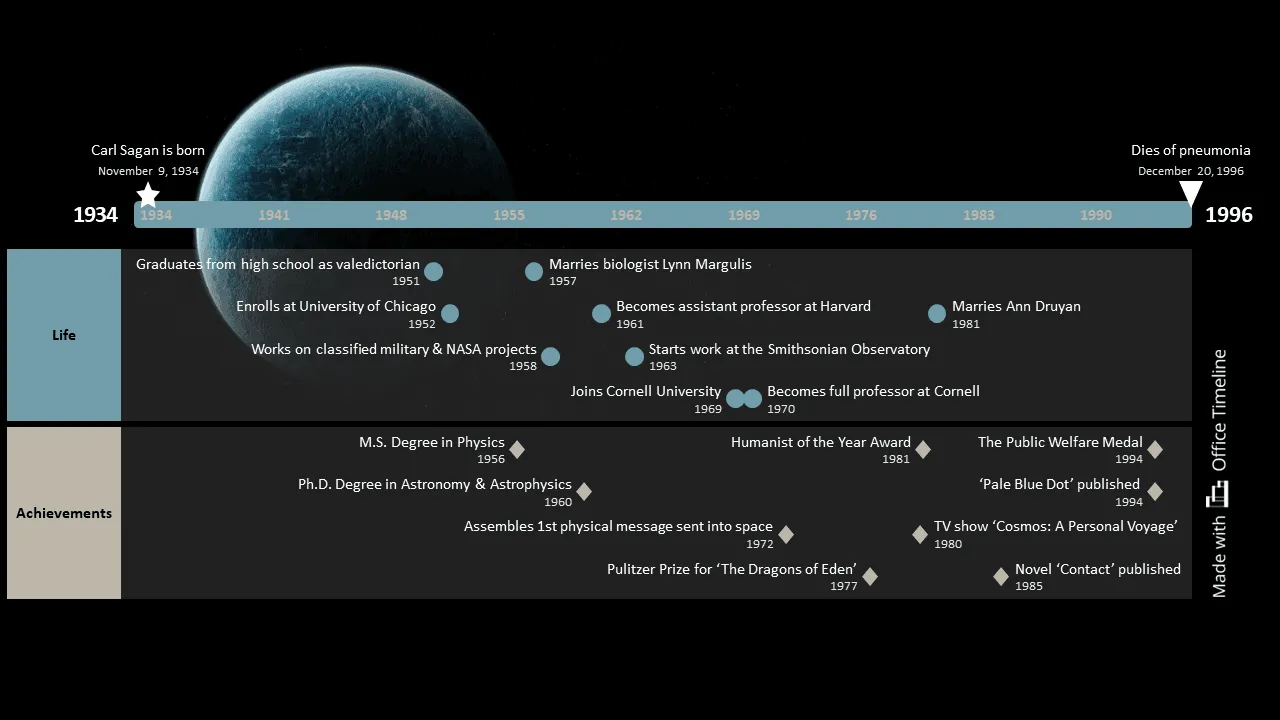Carl Sagan timeline
The Carl Sagan timeline reviews the life and career of the famous cosmologist and science popularizer.
Updated on August 8, 2022
Carl Edward Sagan (November 9, 1934 – December 20, 1996) was an American planetary scientist, astronomer, and cosmologist whose best-known scientific contribution to the field is his research on extraterrestrial life. He was the one to assemble the Pioneer plaque and the Voyager Golden Record, the first physical messages sent into space that could potentially be understood by any extraterrestrial intelligence that might intercept them.
To bring an homage to the creator of “Cosmos: A Personal Voyage”, the most popular series in American public television, we decided to give you an overview of his life and achievements through a condensed visual timeline and a series of answers to the most frequently asked questions about him and his work.
Promoting the Search for Extra-Terrestrial Intelligence (SETI) and pioneering exobiology – the scientific field concerned with the origin and evolution of life in the universe – Carl Sagan explained space in its perplexing glory like no one did before.
Having served as an astronomy professor at Cornell University for almost 30 years, he built an astonishing career by working on NASA’s robotic missions and publishing more than 600 academic papers and articles. He also authored over 20 books addressing the general public, which established his reputation as a science popularizer and communicator and earned him the status of a pop-culture icon.
Almost three decades after his death, Mr. Sagan is still remembered for his candid enthusiasm towards the vast and deeply humbling universe we are so lucky to live in and is fondly referred to as the gatekeeper of scientific credibility by his fans.
Carl Sagan’s abridged biography: a timeline
- 1934, November 9: Carl Sagan is born
- 1951: Graduates from high school as valedictorian
- 1952: Enrolls at University of Chicago
- 1955: Bachelor Science Degree in Physics
- 1956: M.S. Degree in Physics
- 1957: Marries biologist Lynn Margulis (first out of three wives)
- 1958: Work on classified military & NASA projects
- 1960: Ph.D. Degree in Astronomy & Astrophysics
- 1961: Becomes assistant professor at Harvard
- 1963: Starts working at the Smithsonian Observatory
- 1964: Second marriage to artist Linda Salzman
- 1969: Joins Cornell University
- 1970: Becomes full professor at Cornell
- 1972: Assembles 1st physical message sent into space
- 1972: His book “The Dragons of Eden” wins Pulitzer Prize
- 1980: His TV show “Cosmos: A Personal Voyage” airs
- 1981: Remarries for 3rd time (to author Ann Druyan)
- 1981: Receives “Humanist of the Year” Award
- 1985: Publishes science fiction novel “Contact”
- 1994: Receives the Public Welfare Medal
- 1995: “Pale Blue Dot: A Vision of the Human Future in Space” comes out
- 1996, December 20: Dies of pneumonia
Frequently asked questions about Carl Sagan
For more interesting facts about the man who has been considered the face of science itself by many in America, here are some of the most frequently asked related questions:
Starting with the 1950s, Carl Sagan became a consultant and advisor to NASA, playing a leading role in the American space program from its beginning. He was the one to brief the Apollo astronauts before their flights to the Moon.
A firm advocate of the skeptical scientific inquiry and the scientific method, Carl Sagan also believed that knowledge should be put at the general public’s service as best as possible. Here is one of his most famous quotes to summarize this belief:
“It is the responsibility of scientists never to suppress knowledge, no matter how awkward that knowledge is, no matter how it may bother those in power; we are not smart enough to decide which pieces of knowledge are permissible and which are not.”
Apart from his extensive research on extraterrestrial life and pioneering work on the field of exobiology in the academic environment, Carl Sagan is also famous for creating the popular Cosmic Calendar, a chronological arrangement under the form of a scale in which the 13.7-billion-year lifespan of the universe is mapped onto a single year.
According to the chronology of the universe illustrated on Sagan’s Cosmic Calendar, humans appeared so recently in its history that “our recorded history occupies only the last few seconds of the last minute of December 31st.”
In 1991, Carl Sagan was nominated for membership in the National Academy of Science but was denied admission, lacking enough endorsing votes. It was the Academy’s rejection of Sagan, along with Harvard’s prior denial of his tenure, that made Sagan’s biographers talk about the phenomenon which has become known as the Sagan Effect:
“the perception that popular, visible scientists are worse academics than those scientists who do not engage in public discourse. Yet, later analyses of Sagan’s output have indicated that his academic contributions compared favorably to those of other Academy members.”
As a consultant and adviser to NASA, Carl Sagan helped solve the mysteries of the high temperature of Venus (a massive greenhouse effect), the seasonal changes on Mars (windblown dust), and the reddish haze of Titan (complex organic molecules).
For his work, he received numerous awards that were to honor:
“[…] his extraordinary contributions to the development of planetary science… As a scientist trained in both astronomy and biology, Dr. Sagan made seminal contributions to the study of planetary atmospheres, planetary surfaces, the history of the Earth, and exobiology. Many of the most productive planetary scientists working today are his present and former students and associates.” (The Planetary Society)
Among the many accolades received are:
- NASA Medal for Exceptional Scientific Achievement,
- NASA Medal for Distinguished Public Service,
- NASA Apollo Achievement Award,
- John F. Kennedy Astronautics Award of the American Astronautical Society,
- Joseph Priestley Award, "For distinguished contributions to the welfare of mankind",
- Masursky Award of the American Astronomical Society.
About the Carl Sagan Timeline
Our visual chronology of Carl Sagan’s life was created with the Office Timeline add-in for PowerPoint, a simple-to-use tool that quickly builds impressive timelines and other similar visuals. The slide, which is free to copy and share, can be edited, and updated using Office Timeline free trial. Download the Carl Sagan timeline for PowerPoint for free and add it to your presentation.
Eddy is Co-Founder & Chief Product Officer for Office Timeline, building a user-friendly but powerful app that makes timelines, Gantt charts and roadmaps directly in PowerPoint.
Turn project data into professional timelines
Get the advanced features of Office Timeline free for 14 days.



